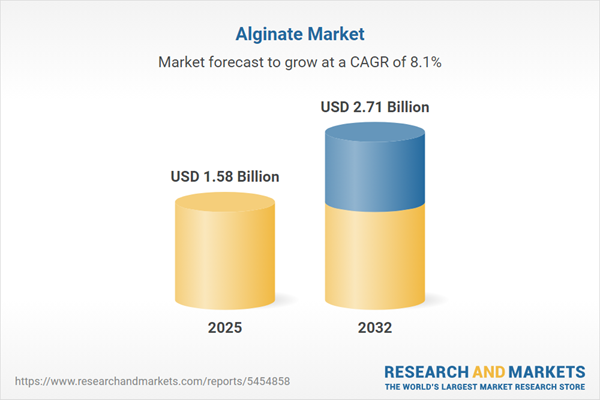Speak directly to the analyst to clarify any post sales queries you may have.
Alginate continues to gain strategic prominence as a versatile natural polymer, offering advanced solutions across food, pharmaceuticals, construction, and other industrial applications. This executive summary offers an actionable overview for senior decision-makers projecting the future trajectory and competitive shape of the global alginate market.
Market Snapshot: Global Alginate Market Growth & Trajectory
The Alginate Market grew from USD 1.46 billion in 2024 to USD 1.58 billion in 2025. It is expected to continue growing at a CAGR of 8.07%, reaching USD 2.71 billion by 2032.
Alginate’s strong performance is propelled by a surge in sustainable product demand, innovation in bioprocessing, and intensifying requirements across established and emerging industries. Market maturation is supported by regulatory changes, evolving trade policies, and a rising focus on functional ingredient value.
Scope & Segmentation
This report delivers a detailed segmentation and regional analysis of the global alginate market. The market is structured by diverse forms, functions, end-use applications, and grades, providing targeted insights to stakeholders:
- Form: Ammonium Alginate, Calcium Alginate, Potassium Alginate, Sodium Alginate
- Functionality: Encapsulating Agent, Film Former, Gelling Agent, Stabilizer, Thickener
- Application: Construction (Coatings, Sealants and Adhesives), Food & Beverage (Bakery Products, Beverages, Confectionery, Dairy Products), Pharmaceuticals & Cosmetics (Cosmetics Formulations, Drug Delivery Systems, Wound Dressings), Textile & Printing (Printing Inks, Textile Finishing)
- Grade: Food Grade, Industrial Grade, Pharmaceutical Grade
- Regional Coverage: Americas (United States, Canada, Mexico, Brazil, Argentina, Chile, Colombia, Peru), Europe, Middle East & Africa (United Kingdom, Germany, France, Russia, Italy, Spain, Netherlands, Sweden, Poland, Switzerland, United Arab Emirates, Saudi Arabia, Qatar, Turkey, Israel, South Africa, Nigeria, Egypt, Kenya), Asia-Pacific (China, India, Japan, Australia, South Korea, Indonesia, Thailand, Malaysia, Singapore, Taiwan)
- Leading Companies: Cargill, Incorporated; FMC Corporation; Algaia S.A.S.; Alginor ASA; J. Rettenmaier & Söhne GmbH + Co. KG; Kimica Corporation; Ingredion Incorporated; Gelymar S.A.; Qingdao Bright Moon Seaweed Group Co., Ltd.; Ashland Global Holdings Inc.
Key Takeaways
- Alginate’s gelling and film-forming functionality addresses critical challenges in food stability, advanced wound management, and environmentally conscious construction materials.
- Shifts to sustainable seaweed sourcing and enhanced bioprocessing standards underpin industry priority on eco-friendly ingredient development and regulatory compliance.
- Digital technologies foster new levels of traceability, enabling real-time monitoring and driving consistent product quality in increasingly complex supply chains.
- Cross-industry partnerships and innovation alliances drive the next generation of high-purity alginate derivatives for specialized pharmaceutical and packaging applications.
- Regionally, accelerated investments in biomanufacturing, supportive regulatory frameworks, and local seaweed cultivation are shaping resilient supply chains and opening new avenues for market participation.
- Companies are adopting agile operational models, diversifying sourcing, and customizing formulations to enhance competitive differentiation and long-term client retention.
Tariff Impact: United States Policy Shifts
Recent and anticipated United States tariffs have increased cost pressures in global alginate trade. This development is prompting manufacturers to strengthen domestic supply networks, explore regional procurement options, and invest in upstream feedstock security. Companies are recalibrating logistics strategies and accelerating nearshoring practices to moderate tariff-induced volatility and preserve competitiveness. Consequently, local seaweed cultivation and processing capacity gains have emerged as vital risk mitigation levers within North American supply chains.
Methodology & Data Sources
This report’s findings are grounded in primary interviews with key stakeholders—including cultivators, engineers, product developers, and regulatory experts—supplemented by secondary research across trade journals, technical patents, and company disclosures. Quantitative validation was ensured through triangulation, while analytical tools such as SWOT, Porter’s Five Forces, and PESTEL analyses contextualized market and competitive structures. Rigorous quality assurance steps verified the integrity of all insights presented.
Why This Report Matters
- Gain a comprehensive understanding of the evolving alginate market, with granular insights on segmentation, technology, and regulation.
- Support strategic planning by accessing actionable recommendations on innovation, sustainability, and resilient supply chain practices.
- Confidently identify partnership and investment opportunities tailored to industry-specific needs and emerging value pools.
Conclusion
As the alginate market expands and transforms, effective leadership will depend on leveraging innovation, robust supply networks, and collaborative strategies. This report empowers decision-makers to navigate market complexity and unlock new growth opportunities across global industries.
Additional Product Information:
- Purchase of this report includes 1 year online access with quarterly updates.
- This report can be updated on request. Please contact our Customer Experience team using the Ask a Question widget on our website.
Table of Contents
3. Executive Summary
4. Market Overview
7. Cumulative Impact of Artificial Intelligence 2025
List of Figures
Samples

LOADING...
Companies Mentioned
The key companies profiled in this Alginate market report include:- Cargill, Incorporated
- FMC Corporation
- Algaia S.A.S.
- Alginor ASA
- J. Rettenmaier & Söhne GmbH + Co. KG
- Kimica Corporation
- Ingredion Incorporated
- Gelymar S.A.
- Qingdao Bright Moon Seaweed Group Co., Ltd.
- Ashland Global Holdings Inc.
Table Information
| Report Attribute | Details |
|---|---|
| No. of Pages | 189 |
| Published | October 2025 |
| Forecast Period | 2025 - 2032 |
| Estimated Market Value ( USD | $ 1.58 Billion |
| Forecasted Market Value ( USD | $ 2.71 Billion |
| Compound Annual Growth Rate | 8.0% |
| Regions Covered | Global |
| No. of Companies Mentioned | 11 |









